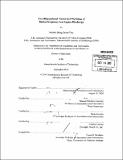| dc.contributor.advisor | Manuel Martinez-Sanchez. | en_US |
| dc.contributor.author | Tsay, Michael Meng-Tsuan | en_US |
| dc.contributor.other | Massachusetts Institute of Technology. Dept. of Aeronautics and Astronautics. | en_US |
| dc.date.accessioned | 2011-05-09T15:24:01Z | |
| dc.date.available | 2011-05-09T15:24:01Z | |
| dc.date.copyright | 2010 | en_US |
| dc.date.issued | 2010 | en_US |
| dc.identifier.uri | http://hdl.handle.net/1721.1/62713 | |
| dc.description | Thesis (Ph. D.)--Massachusetts Institute of Technology, Dept. of Aeronautics and Astronautics, 2010. | en_US |
| dc.description | Cataloged from PDF version of thesis. | en_US |
| dc.description | Includes bibliographical references (p. 106-109). | en_US |
| dc.description.abstract | Small satellites are gaining popularity in the space industry and reduction in spacecraft size requires scaling down its propulsion system. Low-power electric propulsion poses a unique challenge due to various scaling penalties. Of high-performance plasma thrusters, the radio-frequency ion engine is most likely to succeed in scaling as it does not require an externally applied magnetic field and is structurally simple to construct. As part of a design package an original two-dimensional simulation code for radio-frequency ion engine discharge is developed. The code models the inductive plasma with fluid assumption and resolves the electromagnetic wave in the time domain. Major physical effects considered include magnetic field diffusion and coupling, plasma current induction and ambipolar plasma diffusion. The discharge simulation is benchmarked with data from an experimental thruster. It shows excellent performance in predicting the load power and the internal power loss of the plasma. Predictability of anode current depends on the operating power but is generally adequate. Optimum skin depth on the order of half of chamber radius is suggested by the simulation. The code also demonstrates excellent scaling ability as it successfully predicts the performance of a smaller thruster with errors less than 10%. Using the code a brief optimization study was conducted and the results suggest the maximum thrust efficiency does not necessarily occur at the same frequency that maximizes the power coupling efficiency of the matching circuit. | en_US |
| dc.description.statementofresponsibility | by Michael Meng-Tsuan Tsay. | en_US |
| dc.format.extent | 109 p. | en_US |
| dc.language.iso | eng | en_US |
| dc.publisher | Massachusetts Institute of Technology | en_US |
| dc.rights | M.I.T. theses are protected by
copyright. They may be viewed from this source for any purpose, but
reproduction or distribution in any format is prohibited without written
permission. See provided URL for inquiries about permission. | en_US |
| dc.rights.uri | http://dspace.mit.edu/handle/1721.1/7582 | en_US |
| dc.subject | Aeronautics and Astronautics. | en_US |
| dc.title | Two-dimensional numerical modeling of Radio-Frequency ion engine discharge | en_US |
| dc.title.alternative | 2-D numerical modeling of Radio-Frequency ion engine discharge | en_US |
| dc.title.alternative | Two-dimensional numerical modeling of RF ion engine discharge | en_US |
| dc.type | Thesis | en_US |
| dc.description.degree | Ph.D. | en_US |
| dc.contributor.department | Massachusetts Institute of Technology. Department of Aeronautics and Astronautics | |
| dc.identifier.oclc | 715259575 | en_US |
